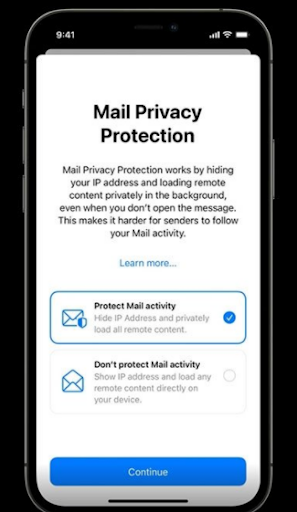 Oct 25, 2021
Persona
Oct 25, 2021
Persona
Your Recent Higher Open Rates Are Misleading: How Apple’s Mail Privacy Protection Will Impact Higher Education Marketers
On June 7, Apple posted a press release detailing the upcoming launch of iOS 15, among several other updates. While there are many key points worth noting, none will impact higher education marketers more than Apple’s new Mail Privacy Protection (MPP) option.
What does this mean and who does it affect?
In mid-September, Apple users began to receive the opportunity to update their operating systems to iOS 15. As part of this update, users were given the option to opt in to Mail Privacy Protection, which “works by hiding your IP address and loading remote content privately in the background, even when you don’t open the message. This makes it harder for senders to follow your Mail activity.” Users can opt in by selecting the defaulted “Protect Mail activity” or can opt out by selecting “Don’t protect Mail activity.”
While it’s unlikely that all users have updated their devices and even less likely that everyone opted in to MPP, this change will no doubt have an impact on data reporting and tracking within email marketing. The most immediate change will be that all emails that pass through MPP will be marked as opened, even if the user does not open them (or moves them directly to trash).
The good news for higher education marketers is that MPP will not affect their entire audience. Prospective students, in turn, must meet the following criteria: (1) Use an iPhone or other Apple device, (2) Make use of Apple Mail to receive their email, and (3) Have opted in to Mail Privacy Protection. Apple Mail is popular, but many students still prefer Gmail. One can thus think of MPP as impacting a subset of a subset of students. Take note, though: emails forwarded to Apple Mail through other accounts (Gmail, Outlook, Yahoo, etc.) will face the same MPP fate.

Why does this matter?
Put simply, any reports that an institution generates to track open rate data will be skewed upward. The changes in how email applications mark incoming mail will also mean that more students will receive strategic outreach that targets students who have opened previous emails, if the institution uses them. Though in many ways, more students receiving these targeted emails is not always a bad practice. All these changes also mean the way institutions track a student’s demonstrated interest may not be consistent. If two students appear to have opened an email from an institution, it will be difficult to discern that one student opened the email through Gmail on an Android phone while the other left the message unread on their iPhone’s Apple Mail app.
What can you do about it?
There are myriad ways to report data and track student engagement that rely less heavily on open rate data. Certainly, open rate data has been the gold standard for a long time; we encourage still using it. But Carnegie also recommends the following:
- Contextualize, don’t ditch: Instead of completely abandoning open rate data in reports, keep an eye on it to see what impact your institution is seeing as a result of MPP. You can do this first by comparing year-over-year data on messages sent. Are this year’s emails opening at a significantly higher rate than last year’s emails? If so, MPP might be the cause. If not, it could be that a smaller percentage of your audience was impacted by MPP. Once institutions see their open rates plateau and reach a new normal, you’ll likely be able to use open rates as a general comparison tool of success email-to-email during a cycle instead of a year-over-year comparison. If the data is or seems volatile, then you might consider a…
- Shift to clicks: Use click rate data, which will not be impacted by MPP. While reporting on how many students have opened your first application generation email will be more difficult, you’ll still be able to track how many students clicked that link to take them to your online application. Admittedly, click rates will never be as robust or inspiring as open rate data. But that may inspire you to…
- Re-evaluate: When one door closes, another one opens. Use MPP to re-evaluate your institutional marketing strategy. Do you have compelling subject lines? Is your institutional narrative a compelling one? Do your messages offer the opportunity to click to learn more about your institution? What are your calls to action? Remember: Carnegie is here to help you with your higher education marketing and enrollment strategy. Are you a Technolutions Slate user? Then Carnegie’s Underscore division could be a great fit for your team – reach out!
The bottom line
Apple’s Mail Privacy Protection on iOS 15 is a significant change that will likely set a precedent for other tech companies to follow. All things considered, the Carnegie team is not overly concerned, and for one specific reason: at the end of the day, higher education marketers are most concerned with recruiting high-quality students who yield and retain. MPP will not impact that directly. Instead, this change will impact how a subset of a subset is tracked for their engagement with institutional marketing. We are firm believers that while MPP might impact a prospective student’s digital journey, it will not impact their destination.
Not sure where to get started with email metrics or email marketing strategy? Contact us to see how we can support your goals.
